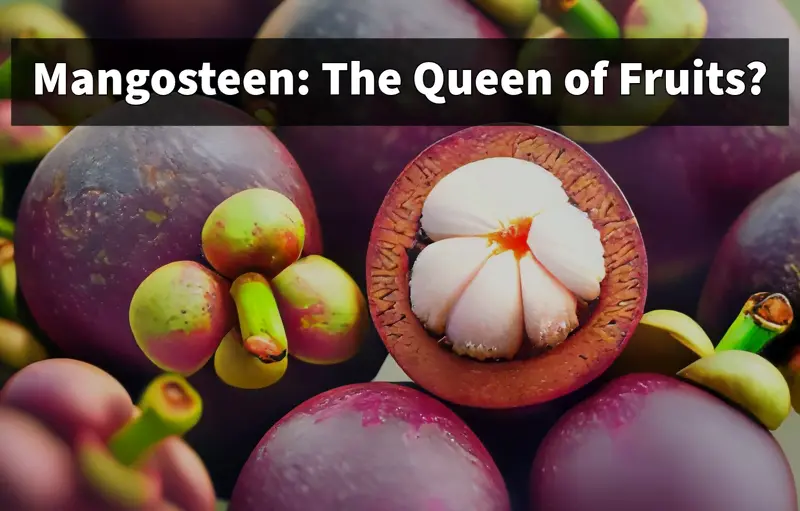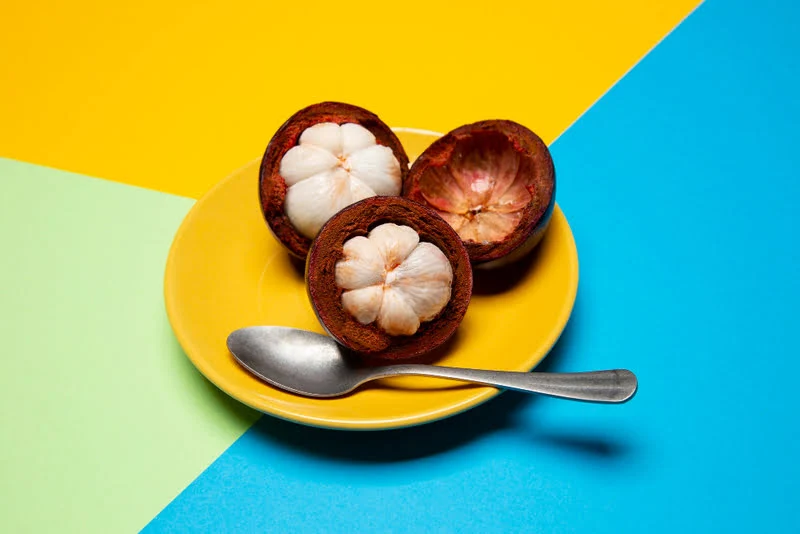Hello everyone searching for the queen of fruits? Look no further here is the Lucious dark purple mangosteen also known as the “Queen of fruits”. This exotic fruit is super nutritious and has some incredible health benefits. Read on to learn why mangosteen deserves its royal nickname.
Table of Contents
What is Mangosteen?
Mangosteen is a tropical, reddish-purple fruit that is grown in Southeast Asia such as India, Indonesia, Thailand, Malaysia, Brazil, Philippines, and also in several regions.
The mangosteen fruit itself is about 3-4 inches in diameter. It has a thick, dark rind on the outside which protects the soft, delicately sweet, white pulp fruit inside. The inside of a mangosteen contains 4-8 triangular segmented pieces of white fruit.
Why is Mangosteen Called the Queen of Fruits?

Mangosteen is referred to as the queen of fruits for several reasons:
It has a regal, majestic appearance. The deep reddish-purple rind looks like the robes of royalty. When you slice it open, the fragrant, white flesh looks like the Queen’s jewels.
Mangosteen has a superior, complex flavor. It tastes sweet, tangy, slightly sour, and creamy all at once – fit for a queen’s palate. The flavor is so unique that it’s almost impossible to compare it to any other fruit.
Mangosteen contains powerful health compounds like antioxidants and xanthones. These make it healthier than most fruits, which gives it a medicinal quality fit for royalty.
Mangosteen is rare and hard to cultivate. Because of this, it is not widely available and can be expensive to obtain. Its rarity adds to its regal reputation.
The mangosteen tree takes years to mature and produce fruit, requiring patience and care. The end result – the mangosteen fruit – is worth the wait, just as a royal treasure is worth seeking.
Nutrition Facts of Mangosteen
One of the reasons mangosteen is so beneficial is that it is packed with nutrients. Here is the nutrition breakdown for 1 cup (196 grams) of mangosteen:
| Calories | 143 |
| Protein | 1.3 grams |
| Fiber | 5.4 grams |
| Vitamin C | 12% of RDI |
| Vitamin B6 | 9% of RDI |
| Manganese | 27% of RDI |
| Copper | 9% of RDI |
| Potassium | 12% of RDI |
| Magnesium | 10% of RDI |
Mangosteen also contains xanthones, powerful antioxidants with medicinal properties. The xanthones α-mangostin and γ-mangostin are found almost exclusively in mangosteen.
6 Evidence-Based Health Benefits of Mangosteen
Scientists have conducted several studies on mangosteen throughout the years in order to find out its health benefits in humans. More research is required to discover its hidden potential. Some of the known benefits are immunity boosters, reduced inflammation, and improved overall wellness. Let’s see in depth of these health benefits:
Rich in Antioxidants and Anti-Inflammatory Compounds
The Mangosteen is packed with unique antioxidants such as vitamin C and folate that are responsible for protecting our body from harmful radiation or free radicals that cause chronic diseases.
The fruit consists of anti-inflammatory compounds such as Xanthones and flavonoids. helps in reducing inflammatory diseases such as cancer, arthritis, atherosclerosis, Asthma, and ulcerative colitis.
More studies are required to know that the fruit actually reduces inflammation in humans. but in animals, it produces an Anti-inflammatory effect.
May Lower Blood Sugar Levels
Mangosteen may help improve blood sugar regulation, especially in people with diabetes. Human studies show that mangosteen extract helps in reducing blood sugar in both healthy and diabetic patients. The xanthones appear to act directly on tissue to improve glucose uptake.
Anti-Cancer Properties
Several animal studies suggest that mangosteen’s xanthones may have anti-tumor effects and inhibit cancer cell growth. The enzyme blocks the cell mutations and kills cancer cells. Human research is still insufficient, but mangosteen has a potential future in cancer treatment.
Antibacterial Properties
Traditionally, mangosteen was used to treat infections. The rind of the fruit contains antibacterial compounds that help in fighting against micro-organisms like Staphylococcus aureus and Escherichia coli. The extracts of this fruit may also aid in inhibiting the growth of tuberculosis bacteria.
Boosts Immunity
Mangosteen has essential nutrients such as vitamins C, A, etc. That boosts the functioning of the immune system. More research is needed to confirm the immunity benefits in humans.
Improves Skin Health
The xanthone compound can protect your skin from free radical damage. Also, they fight acne-causing bacteria. Mangosteen-containing products such as creams, masks, and serums are used to hydrate the skin and minimize wrinkles. The antioxidants shield the skin from sun damage as well.
Queen of Fruits in India: Traditional Uses
The mangosteen holds a special position in Indian traditional medicines which is why is widely known as the “Queen of fruits in India”. Due to its numerous health benefits, it has been a staple in Ayurvedic medicines for centuries.
The fruit’s rind and pulp are used as remedies for treating diarrhea, skin infections, wounds, urinary infections, etc. There is no true evidence that this fruit can cure human diseases more studies are required.
The Rind is traditionally used as a natural dye by Indonesian people for coloring their white hair.
The fruit is believed to possess mystical powers that are used in rituals and ceremonies. Due to this property, it is considered a symbol of luck and prosperity, so the people gift it during the festival seasons.
How to Eat Mangosteen:

Mangosteen can be easily prepared, but it is difficult to find them if you are in Western countries. the fruit is only available in the rainy seasons in India. During the months of April-May and July-October. Steps to eat the mangosteen:
- Go to the nearby supermarket during the season to get fresh mangosteen.
- Avoid picking randomly. Instead, check the shape of the fruit to ensure it has no cracks and juice leaking from inside. Also, check the green cap is attached or else bugs may enter the fruit.
- After buying the mangosteen wash them and Remove the cap on top of the fruit and don’t remove the bottom part.
- Press in with your index finger on top of the fruit you can feel softer and the fruit begins to crack.
- Then squeeze the fruit with a gentle press until the rind cracks and opens.
- if the fruit doesn’t open use a sharp knife to make a horizontal cut until it opens. Also, don’t cut the fruit fully it may damage the pulp inside.
- Once, the shell is opened take the white pulp with your hands and note the pulp contains seeds so remove them before eating and enjoy the taste.
Mangosteen extracts like xanthones are used in smoothies, juices, ointments, soaps, and cosmetics.
The fleshy fruit part can be eaten raw or can be added to various dishes. Add it with fruit salads, yogurts, oatmeal, smoothies, desserts, sarbath (juice), and more. also can be used to make jams.
Check out the video to know more:
Mangosteen: Truly the Queen of Fruits
It deserves to be called “the queen of fruits” for its amazing flavor, beauty, health benefits, and rarity. This exotic superfruit is packed with nutrition to support your health and delicious enough to please any royal palate. Try this fruit whenever you can find it and add it to your diet. Let the mangosteen queen rule over your kitchen!
FAQ:
Who is the queen and king of fruits?
Durian is called the king of fruits and Mangosteen is called the Queen of fruits. Due to their taste, nutritional profiles, and other health benefits.
Is Litchi a fruit queen?
No, Litchi is not the queen of fruits mangosteen is called the queen of fruit in India.
Who is the Princess of Fruit?
Pineapple is called the princess of fruits and is considered the symbol of hospitality.